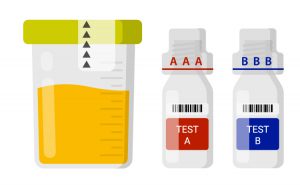
Sample Collection Process
Steps below are general overview of the doping control process. Departures from these procedures will not invalidate a test result unless it is determined that the integrity of the sample has been compromised.
You can be selected for doping control at any time and any place without advance notice and are subject to random and planned selection methods.
A Doping Control Officer (DCO) or Chaperone will notify you of selection for doping control to provide either a urine sample, blood sample or both. You are required to present a photo identification to confirm your identity. The DCO or Chaperone will inform you of your rights and responsibilities. You will be asked to sign the Doping Control Notification form confirming that you have been notified for doping control. A copy of the form will be provided to you for your record. You may also request an athlete representative to accompany you throughout the doping control process.
You are required to report to the doping control station immediately unless you request a delay in reporting for valid reasons. The DCO or Chaperone will accompany you from the time of notification until the completion of the sample collection process. At the doping control station, you will be given a chance to hydrate. Individually sealed beverage will be available.
You are given a choice of at least 3 individually sealed sample collection kits, and you will select one. You should verify that the equipment is intact and has not been tampered with.
Only you and a DCO or Chaperone of the same gender are permitted in the washroom when you provide the urine sample. The first urine sample that you are able to provide following notification must be collected.
Before providing the urine sample, you are required to wash your hands with water, remove any clothing from the knees to the mid-torso and from the hands to the elbows. This provides the DCO or Chaperone with a direct view of the urine leaving your body and into the collection vessel. You are responsible for controlling your sample and keeping it in view of the DCO or Chaperone until it is sealed in a sample collection kit.
Prior to providing a blood sample, the Blood Collection Officer (BCO) or DCO must ensure that you have been seated and relaxed for at least 10 minutes. If a blood sample is being collected for the Athlete Biological Passport, you must have been rested for at least 2 hours.
When providing a blood sample, you will be asked to select from at least 3 sets of blood collection kits, blood sample storage and transportation kits. Checks should be made to ensure they are empty, clean and the seal is intact.
A trained BCO will perform the blood collection procedure in the presence of a DCO or Chaperone and, if applicable, the athlete representative.
The BCO shall assess the most suitable vein for sample collection and clean the site. No more than 3 attempts will be made per session.
You are given a choice of at least 3 individually sealed sample collection kits from which to choose one. You should verify that the equipment is intact and has not been tampered with. You will open the kit and confirm that the sample code numbers on the bottles, the lids, and the container all match. Also verify that the bottles are intact and has not been tampered with.
You will split and pour the urine yourself, unless assistance is required, and you provide consent for your representative or the DCO to do so on your behalf.
Pour at least 30ml of urine into the B bottle and pour the remaining urine into the A bottle.
You will be asked to leave a small amount in the collection vessel so that the DCO can measure the specific gravity. You will then seal the ‘A’ and ‘B’ bottles tightly ensuring there is no leakage.
Sealing and Storing the Blood Sample
After withdrawing the needle, the BCO or athlete will place one vacutainer into each of the ‘A’ and ‘B’ sample bottles. These should be checked for any leakage. The sealed blood sample shall be kept in the Doping Station, at a cool but not freezing temperature, prior to dispatching for analysis.
The DCO will check the specific gravity of the residual urine left in the collection vessel to ensure it is suitable for analysis and will record the value on the Doping Control Test Form.
If the sample falls outside the required range for specific gravity, the DCO will request additional samples to be provided until one within the required range for Specific Gravity is provided, or until the DCO determines that, due to exceptional circumstances, the session should end.
You will be asked to provide information on the doping control form about any medication or supplements taken recently. You should also indicate if there is any granted Therapeutic Use Exemption (TUE) for any prohibited substance or methods used.
You also have the right to note comments on the form regarding the conduct of the doping control session. Be sure to confirm that all the information is correct, including the sample code number. You will receive a copy of the doping control form. Your representative, if present and you will be invited to check that the information recorded on the Doping Control Form is correct, and to sign it if satisfied.
Once the samples are placed in a security sealed transit bag, they are sent to a WADA accredited laboratory, by a secure chain of custody, for analysis. This ensures that every step of the process is fully documented and only those authorized to handle the sample do so.
The copy of the Doping Control Form that the laboratory receives does not contain any information that could identify you.